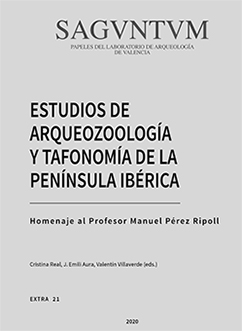Una diversificación temprana de la dieta cárnica: el caso de la Cova del Bolomor (MIS 9-5e, Tavernes de la Valdigna, Valencia)
 Resumen
Resumen
The exploitation strategies of faunal resources have taken a prominent place in discussions about the origin and nature of modern human behavior. Within these, the systematic use of small animals has been a central issue in recent years. Evidence of anthropogenic processing of small prey dates back to Plio-Pleistocene chronologies in Africa; however, its systematic exploitation is not detected in the archaeological record until more recent periods and linked to anatomically modern humans. Despite this, the evidence of consumption of these animals among Neanderthal lineage hominids has multiplied exponentially during last years, especially in the Mediterranean basin. In this study, we present the zooarchaeological data from four levels (XVII, XII, XI and IV) of the stratigraphic sequence of Bolomor Cave (MIS 9-5e, Tavernes de la Valldigna, Valencia, Spain) with the aim of providing a diachronic view of the meat diet in this site and contribute with specific data to the general debate on the diversification of the diet.
 Descargas
Descargas
Descargas
Publicado
Cómo citar
-
Resumen351
-
PDF196
Número
Sección
Licencia

Este obra está bajo una licencia de Creative Commons Reconocimiento-NoComercial-SinObraDerivada 4.0 Internacional.
Con la publicación impresa de los trabajos, los/as autores/as aceptan que el Departament de Prehistòria, Arqueologia i Història Antiga de la Universitat de València pueda permitir la difusión y el libre acceso a través de las direcciones electrónicas y enlaces del editor/a.
El contenido de los trabajos es responsabilidad de los/as autores firmantes y no expresa la posición ni la opinión del Consejo de Redacción.
Las obras que se publican en esta revista están sujetas a los siguientes términos:
1. La revista conserva los derechos patrimoniales (copyright) de las obras publicadas, y favorece y permite la reutilización de las mismas bajo la licencia indicada en el punto 2.
2. Las obras se publican en la edición electrónica de la revista bajo una licencia Creative Commons Reconocimiento-NoComercial-SinObraDerivada 3.0 España (texto legal). Se pueden copiar, usar, difundir, transmitir y exponer públicamente, siempre que se cite la autoría, la url, y la revista, y no se usen para fines comerciales.
3. Los/as autores/as están de acuerdo con la licencia de uso utilizada por la revista, con las condiciones de auto-archivo y con la política de acceso abierto.
4. En caso de reutilización de las obras publicadas debe mencionarse la existencia y especificaciones de la licencia de uso además de mencionar la autoría y fuente original de su publicación.



